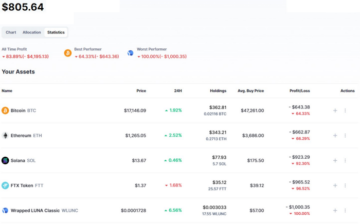
In the evolving landscape of financial technology, innovations in artificial intelligence (AI) have ushered in a new era for trading bots, transforming the way market operations are conducted. These sophisticated algorithms based on Technical Analysis (TA)
and Fundamental Analysis (FA) are not only redefining the approach to trading but are also enhancing the precision and efficiency of market predictions and operations. This article delves into the intricacies of these innovations, offering insights into the
mechanisms and strategies that underpin AI-powered trading bots.
#1 Comprehensive Market Analysis Utilizing Indicators and Volatility Spectra (TA & FA)
-
Trading bots equipped with AI algorithms perform exhaustive analyses by leveraging a blend of short-term, medium-term, and long-term market trends, which are meticulously optimized by quantitative analysts. These analyses encompass an in-depth evaluation
of the price dynamics and volatility of individual stocks over specific periods, aiming to pinpoint the most advantageous moments for initiating both long and short positions. The convergence of signals from both short-term trends and volatility analyses dictates
the bot’s entry into trades, with exits strategically timed either through trailing stops or upon hitting predetermined profit targets.
#2 Correlation Models to Enhance Trade Accuracy (TA & FA)
-
These algorithms employ advanced models to scrutinize the correlations and price movements of stocks within identical industries, paying close attention to those with significant market capitalization. By monitoring the relationship between stocks and their
corresponding industry indices, the bots capitalize on aligned trends to execute trades. The methodology for exiting these trades is governed by predefined stop loss and take profit parameters, ensuring a balanced risk management approach.
#3 Evaluating Financial Health for Informed Trading Decisions (FA)
-
AI-driven trading bots also incorporate a unique model developed by quantitative analysts for assessing a company’s financial stability. This involves a daily scan of key financial metrics across a broad spectrum of stocks listed on major US exchanges. The
collected data is then processed through a proprietary algorithm, ranking each company based on its financial health. Stocks are chosen for trading based on these rankings, with the highest-scoring companies targeted for long positions and the lowest for short
positions. Trades are executed during peak liquidity hours, following the market’s opening, to secure favorable entry points. The bots employ meticulously defined stop-loss orders to safeguard investments, underscoring the emphasis on strategic risk management.
#4 Valuation Model Integration with Inverse ETF Strategies (TA & FA)
-
Incorporating a valuation model that includes the use of Inverse ETFs, these bots offer a safeguard against abrupt market downturns. The core of the valuation algorithm is designed for opening long positions; however, it integrates Inverse ETFs like SRTY
and FAZ to mitigate potential losses during market corrections. These ETFs are analyzed through a series of technical indicators, enabling the bots to open compensatory positions in the face of market reversals. Trailing stops are employed to exit these positions,
further exemplifying the strategic depth of these algorithms.
Algorithmic Trading Strategy Foundations
Developing an algorithmic trading strategy commences with grounding the approach in market prudence and statistical robustness. A successful strategy captures identifiable, enduring market inefficiencies, necessitating a foundation in various analytical
methodologies, including macroeconomic indicators, fundamental and statistical analyses, and an understanding of market microstructure. The creation of a trading bot must reflect personal trading preferences and characteristics, emphasizing the importance
of a tailored approach to algorithmic trading.
Backtesting, Optimization, and Live Execution
Backtesting serves as a critical phase in validating a trading bot, ensuring that it performs as intended across various scenarios and market conditions. Optimizing the bot involves fine-tuning its performance while guarding against overfitting, thereby
enhancing its real-world applicability. As the bot transitions to live trading, it encounters the realities of market and operational risks, necessitating comprehensive risk management strategies and the selection of a reliable broker to navigate the complexities
of live market execution.
Conclusion
The advent of AI-powered trading bots represents a significant leap forward in the domain of financial trading, offering unprecedented levels of analytical depth, precision, and efficiency. These innovations not only facilitate more informed trading decisions
but also open up new avenues for exploring market dynamics, underscoring the transformative impact of AI on the financial industry.
- SEO Powered Content & PR Distribution. Get Amplified Today.
- PlatoData.Network Vertical Generative Ai. Empower Yourself. Access Here.
- PlatoAiStream. Web3 Intelligence. Knowledge Amplified. Access Here.
- PlatoESG. Carbon, CleanTech, Energy, Environment, Solar, Waste Management. Access Here.
- PlatoHealth. Biotech and Clinical Trials Intelligence. Access Here.
- Source: https://www.finextra.com/blogposting/26124/the-impact-of-ai-on-predictive-analytics-in-trading?utm_medium=rssfinextra&utm_source=finextrablogs
- :is
- :not
- $UP
- 1
- 2%
- 5
- 6
- 7
- a
- accuracy
- across
- advanced
- advantageous
- advent
- against
- AI
- AI-powered
- Aiming
- algorithm
- algorithmic
- algorithmic trading
- algorithms
- aligned
- also
- an
- analyses
- analysis
- Analysts
- Analytical
- analytics
- analyzed
- and
- approach
- ARE
- article
- artificial
- artificial intelligence
- Artificial intelligence (AI)
- AS
- Assessing
- attention
- avenues
- balanced
- based
- between
- Blend
- Bot
- both
- bots
- broad
- broker
- but
- by
- capitalization
- capitalize
- captures
- characteristics
- chosen
- Close
- collected
- commences
- Companies
- company
- Company’s
- complexities
- comprehensive
- conditions
- conducted
- Convergence
- Core
- Corrections
- Correlation
- correlations
- Corresponding
- creation
- critical
- daily
- data
- decisions
- defined
- delves
- depth
- designed
- developed
- dictates
- domain
- downturns
- during
- dynamics
- each
- efficiency
- either
- emphasis
- emphasizing
- employed
- enabling
- encompass
- enduring
- enhance
- enhancing
- ensuring
- entry
- equipped
- Era
- ETF
- ETFs
- Ether (ETH)
- evaluating
- evaluation
- evolving
- Exchanges
- execute
- executed
- execution
- exhaustive
- Exit
- Exiting
- exits
- Exploring
- Face
- facilitate
- favorable
- financial
- financial health
- financial stability
- financial technology
- Finextra
- following
- For
- Forward
- Foundation
- from
- fundamental
- further
- governed
- Have
- Health
- hitting
- HOURS
- However
- HTTPS
- identical
- identifiable
- Impact
- importance
- in
- in-depth
- includes
- Including
- incorporate
- Indicators
- Indices
- individual
- industries
- industry
- inefficiencies
- informed
- initiating
- innovations
- insights
- Integrates
- integration
- Intelligence
- intended
- into
- intricacies
- inverse
- Investments
- involves
- IT
- ITS
- jpg
- Key
- landscape
- Leap
- levels
- leveraging
- like
- Liquidity
- Listed
- live
- Long
- long-term
- loss
- losses
- lowest
- Macroeconomic
- major
- management
- Market
- Market Analysis
- Market Capitalization
- market conditions
- market predictions
- Market Trends
- mechanisms
- methodologies
- Methodology
- meticulously
- Metrics
- Mitigate
- model
- models
- Moments
- monitoring
- more
- most
- movements
- must
- Navigate
- necessitating
- New
- of
- offer
- offering
- on
- only
- open
- opening
- operational
- Operations
- optimization
- optimized
- optimizing
- or
- orders
- over
- parameters
- paying
- Peak
- perform
- performance
- performs
- periods
- personal
- phase
- plato
- Plato Data Intelligence
- PlatoData
- points
- positions
- potential
- Precision
- Predictions
- predictive
- Predictive Analytics
- preferences
- price
- processed
- Profit
- proprietary
- quantitative
- Ranking
- real world
- realities
- Redefining
- reflect
- relationship
- reliable
- represents
- reversals
- Risk
- risk management
- risks
- robustness
- safeguard
- scan
- scenarios
- secure
- selection
- Series
- serves
- Short
- short-term
- signals
- significant
- sophisticated
- specific
- Spectrum
- Stability
- statistical
- Stocks
- Stop
- Stops
- Strategic
- Strategically
- strategies
- Strategy
- successful
- tailored
- Take
- targeted
- targets
- Technical
- Technical Analysis
- Technology
- that
- The
- their
- then
- thereby
- These
- this
- those
- Through
- Timed
- to
- trade
- trades
- Trading
- trading bot
- Trading Bots
- trading strategy
- transformative
- transforming
- transitions
- Trends
- underpin
- understanding
- unique
- unprecedented
- upon
- us
- use
- ushered
- Utilizing
- validating
- Valuation
- various
- Volatility
- Way..
- which
- while
- with
- within
- zephyrnet











